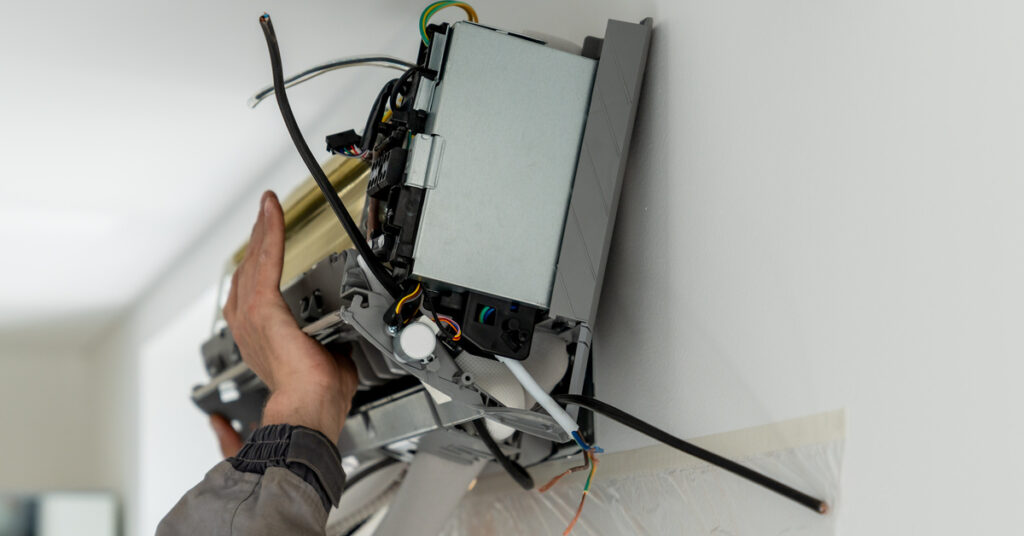Staying comfortable at home can be challenging, especially with fluctuating temperatures throughout the year. While many homes rely on ducted central heating and cooling systems, not all houses have this technology. That’s where mini-split systems come in to save the day.
Mini splits are popular in homes and condo buildings due to their ease of installation, energy efficiency, and zoning capabilities. They’re also a great solution for older homes that lack proper ductwork or have limited space for traditional HVAC systems. This guide will explain everything you need to know about mini splits.
What Are Mini Splits?
Mini splits, or ductless systems, comprise two main components to efficiently manage climate control. Unlike traditional HVAC systems that rely on extensive ductwork, mini splits use an outdoor compressor/condenser and an indoor air handling unit that mounts onto the wall or ceiling.
The outdoor compressor/condenser presses and circulates the refrigerant necessary for temperature regulation. Meanwhile, the indoor air-handling unit distributes the conditioned air into the room. This separation allows for more precise control of individual zones, providing tailored comfort where you need it most.
How Do Mini Splits Work?
Similar to traditional central HVAC systems, mini splits use a compressor to circulate refrigerant between the outdoor and indoor units. The refrigerant absorbs heat from inside your home, transfers it outside through the compressor, and then brings cool air back in.
The difference is that mini splits don’t require extensive ductwork to transfer the conditioned air throughout the house. Instead, they use small pipes that connect the indoor unit to the outdoor unit. This allows for more flexibility in placement and installation and more efficient energy usage.
What Are the Types of Mini Splits?
There are two main types of mini-split systems that you need to know: single-zone and multi-zone. Single-zone systems consist of one outdoor unit connected to a single indoor unit, making them ideal for smaller spaces or for providing targeted cooling/heating in specific rooms.
On the other hand, multi-zone systems consist of one outdoor unit that can connect to multiple indoor units. This allows for more control over different zones within a home, making it an excellent solution for larger homes or buildings with varying temperature needs.
Who Should Have Mini Splits?
Mini splits are ideal for various applications, from residential to commercial spaces. Their ductless design is particularly beneficial for older homes lacking existing ductwork, eliminating the need for invasive and expensive renovations.
Moreover, the versatility of a mini-split system also makes them suitable for various room types, including basements, garages, and attics, where traditional systems might struggle.
Depending on your needs, you may have a traditional HVAC system and a mini-split system working in tandem for optimal comfort and energy efficiency. For example, while a ducted system may handle your home’s primary heating and cooling, a mini split can provide additional targeted comfort in specific areas, such as a sunroom.
What Are the Benefits of Mini Splits?

A mini split is essential in properties without duct systems, but you can also choose to install one even if you have existing ductwork; this allows for individualized climate control in specific rooms or zones.
Other reasons to have a mini split in your space include:
- Cost-effective
- Energy efficient
- Easy to install
- Compact
- Flexible
Below, we’ve gone into more detail on each of these benefits to help you decide whether purchasing a mini split is the ideal option.
Cost-Effective
One of the most appealing aspects of mini splits is their cost-effectiveness, especially if your property doesn’t have ductwork. Adding ducts to an existing home can cost thousands of dollars and may require you to relocate while renovations take place. Since mini splits eliminate the need for costly renovations, the main costs stem from the actual purchase and installation of the system itself.
Energy Efficient
A mini split’s ability to operate independently in different zones means less energy waste, as you only condition the spaces in use. This targeted approach reduces the overall energy consumption, contributing to cost savings and a smaller carbon footprint.
Easy To Install
Installation of mini splits is usually more straightforward than that of a traditional HVAC system. Without extensive ductwork, you can have these units set up quickly and with minimal disruption.
Keep in mind that each indoor unit has its thermostat, so you may need to plan their location carefully for optimal temperature control.
Compact
The compact design of mini splits allows them to fit seamlessly into any area, especially in condos with limited space. Their small size also means you can install them in areas where traditional systems can’t go, such as tight crawlspaces or attics.
Improve Air Quality
Air quality is crucial for a healthy living environment, and mini splits contribute positively. When equipped with advanced filtration systems, they effectively remove dust, allergens, and other pollutants from the air. This results in cleaner, fresher indoor air that benefits everyone who lives or works in the space.
How To Maintain Your Mini Split System

Your mini split keeps your home at a comfortable temperature all year round, so proper maintenance is essential for optimal performance. You should take care of your mini split just like you would a traditional HVAC system.
To keep your mini split working properly, you should:
Schedule Consistent Maintenance
Regular maintenance ensures your mini split operates efficiently and effectively for years to come. Examples of this include:
- Cleaning or changing filters
- Checking and maintaining refrigerant levels
- Scheduling professional tune-ups
While you can do some maintenance yourself, you should have a professional HVAC technician perform routine inspections and tune-ups at least once a year. They can identify potential issues and perform necessary repairs before they become bigger, costlier problems.
Hire a Professional
Whether you want to install a mini split or need maintenance for an existing system, hiring a professional is always best. They have the expertise and experience to properly install and maintain your mini split, ensuring it operates at its full potential. Hiring a professional can save you time and hassle in the long run.
Contact Style Crest
Mini splits offer many benefits, making them an appealing choice for homes or businesses looking to upgrade their climate control systems. Style Crest offers mini split installation service to homeowners in Melbourne, FL, and the surrounding area. Contact our team to learn more about our services and to schedule your appointment.